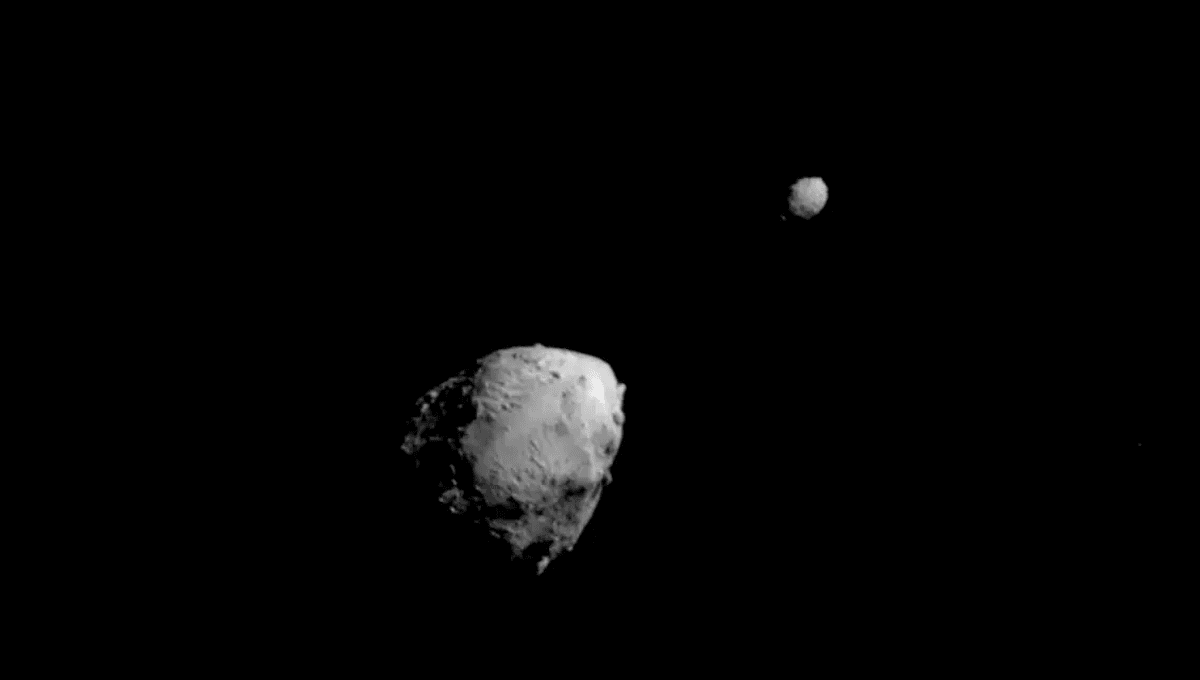
NASA’s DART mission is future tech made reality today. In 2022, the mission demonstrated that it is possible for humans to push potentially dangerous asteroids into a different orbit away from Earth. It did so by smashing a spacecraft into – and subsequently successfully changing the orbit – of Dimorphos, the moon of asteroid Didymos. This was the first time humanity has ever moved a celestial body. But it might have done more. It might have created a future meteor shower.
DART was a kinetic impactor. A car-sized spacecraft sent at full speed against an asteroid about 150 meters (490 feet) across. The impact released boulders and a plume of debris far beyond the asteroid pair. DART was accompanied by a small CubeSat from the Italian Space Agency called LICIACube, which observed the collision. New simulations of the plume of debris based on the observations have revealed that Mars and Earth might both get the bits of Dimorphos delivered to their front door.
This finding suggests that future Mars observation missions might have a real chance of detecting meteors on Mars that were produced by the DART impact.
Dr Eloy Peña-Asensio
“One of the most exciting results from our simulations was the discovery of launch trajectories due to the DART impact of Dimorphos compatible with delivery towards Mars. That is, based on early observation of LICIACube, a small satellite that flew with DART to separate just before the collision and observed the ejecta cone, some particles (< 500 m/s) could reach Mars in about 13 years,” lead author Dr Eloy PeñaAsensio, from the Politecnico di Milano, told IFLScience.
“This finding suggests that future Mars observation missions might have a real chance of detecting meteors on Mars that were produced by the DART impact.”
The team had to employ supercomputing facilities to work this out, simulating 3 million particles of various sizes and at a variety of speeds and directions. The particles moving at 500 meters per second (~1,120 mph or 1,802 km/h) will reach Mars in over a decade, but some small chunks of Dimorphos might reach Earth in just seven years, and they move 3.5 times faster.
“Our simulations revealed that faster-moving particles could potentially reach Earth in 7 years for those with 1.8 km/s. However, observations of the impact with telescopes have determined that particles at such velocity would not be large enough to produce observable meteors,” Dr Peña Asensio told IFLScience.
[W]hether the DART impact has launched Dimorphos particles at velocities high enough to reach Earth will be determined in the coming decades. If it does happen, we may witness the first human-made meteor shower
Dr Eloy Peña-Asensio
The work of the simulations doesn’t preclude the arrival of slower particles from Dimorphos to Earth, however, they will just take a while longer to get into the orbit of our planet and settle into a meteor shower. Still, the team expected the newly dubbed Dimorphids to be easy to spot.
“In any case, whether the DART impact has launched Dimorphos particles at velocities high enough to reach Earth will be determined in the coming decades through meteor observation campaigns. If it does happen, we may witness the first human-made meteor shower,” Dr Peña-Asensio told IFLScience.
“Our results suggest that these meteors, the so-called Dimorphids, will be relatively easy to identify thanks to the predictions we provide in our work. For example, they would primarily occur in May, would be slow-moving meteors, and would be mostly observable from the Southern Hemisphere.”
So let’s try to be somewhere south of the equator with a nice dark sky in May 2055.
While it will take time for this work to be confirmed by actually observing a meteor from Dimorphos, what it also shows is the importance of CubeSats in space exploration. We wouldn’t know about this without LICIACube. Even two years on, researchers are still working on understanding the whole dataset.
“The precise estimation of the size and velocity distribution of the plume near Dimorphos, as observed in LICIACube images, remains an open question. Long-term monitoring of the tail can provide insights into size distributions extending up to tens of centimeters, while impact simulations help refine the initial velocity profiles of the ejected material,” LICIACube team member Dr Stavro Ivanovski from INAF-Trieste and an adjoint professor at the University of Trieste told IFLScience.
“Ongoing analysis by the LICIACube team plays a pivotal role in enhancing our understanding of ejecta dynamics, dust clumps, and reconstructing the plume.”
Recent studies have provided a better understanding of the plume of debris, in terms of structure and in terms of speed of the debris. The complexities of modeling such an event cannot be underestimated but the LICIACube team continues to rise to the challenge. There is plenty currently in the works from them that will provide insights into what happened to Dimorphos. More follow-ups will be provided by the European Space Agency’s Hera mission, which will launch in October and get to Didymos in 2026.
A paper describing the simulation is accepted for publication in The Planetary Science Journal and is available on the ArXiv.
Source Link: NASA Might Have Accidentally Created The First Human-Caused Meteor Shower